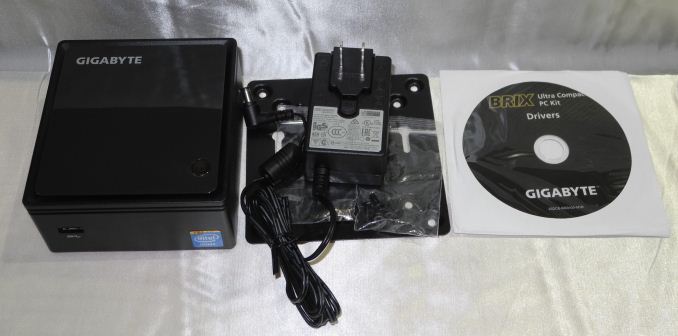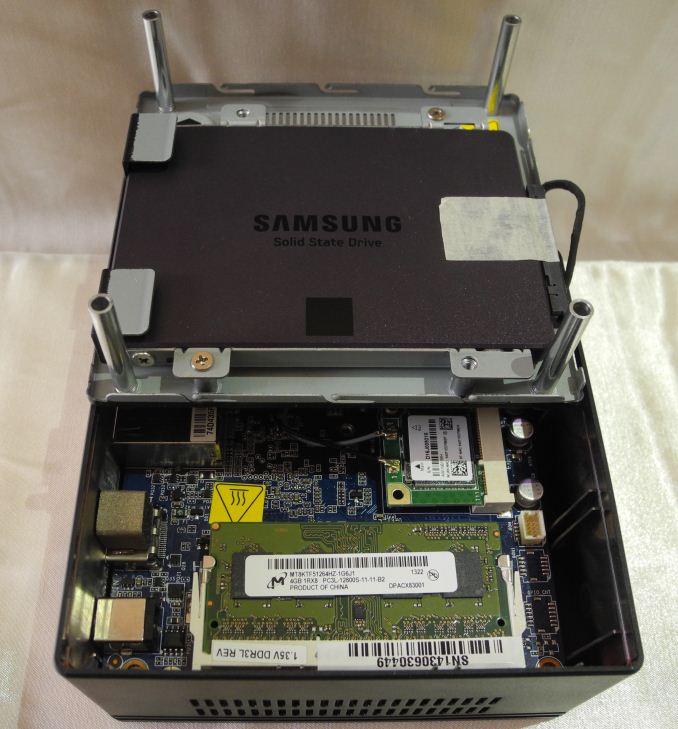GIGABYTE BRIX GB-BXBT-1900 Review: A Bay Trail UCFF PC
by Ganesh T S on October 24, 2014 12:10 PM EST
Introduction and Setup Impressions
Over the last couple of years, the ultra-compact form factor (UCFF) has emerged as one of the bright spots in the troubled PC market. Intel kickstarted the category with their Sandy Bridge NUC kits in early 2013. Recognizing the popularity of this segment, other vendors also began to promote similar products. GIGABYTE targets this market segment with an extensive lineup of products under the BRIX brand. We recently looked at the high-end Haswell BRIX, the GB-BXi7-4500. The focus of this review is on the opposite side of the spectrum - they Bay Trail-D Celeron J1900-based GB-BXBT-1900. As a note, due to GIGABYTE's regional marketing policies, this model is currently not being sold in the North American market, but targets price conscious buyers everywhere else.
Similar to other BRIX units, the BXBT-1900 comes barebones. An important point to note is that, unlike the higher-end BRIX units, the BXBT-1900 doesn't support mSATA drives. The support for 2.5" drives makes the z-height a bit more than the BRIX s (pure mSATA) models that we have looked at before. The dimensions (56.1 mm x 107.6 mm x 114.4 mm) otherwise conform to the smallest possible BRIX units (29.9 mm x 107.6 mm x 114.4 mm). Another point of difference is the presence of only one SO-DIMM DDR3L slot rated for operation at 1333 MHz (compared to the dual 1600 MHz-capable slots in the Haswell-based units). We configured the review unit to end up with the following components:
| GIGABYTE GB-BXBT-1900 Specifications | |
| Processor | Intel Celeron J1900 (4C/4T x 2.00 GHz (2.41 GHz Turbo), 22nm, 2MB L2, 10W) |
| Memory | 1 x 4GB DDR3L-1600 |
| Graphics | Intel HD Graphics |
| Disk Drive(s) | Samsung SSD 840 EVO 120GB 2.5" SSD |
| Networking | 1x Gigabit Ethernet, 1x1 802.11n/Bluetooth mPCIe |
| Audio | Capable of 5.1/7.1 digital output with HD audio bitstreaming (HDMI) |
| Operating System |
Retail unit is barebones, but we installed Windows 8.1 Pro x64 |
| Pricing (As configured) | ~$170 (barebones) + $129 (DRAM + 2.5" SSD) |
| Full Specifications | GB-BXBT-1900 Specifications |
The BXBT-1900 kit doesn't come with any pre-installed OS, but does come with a driver CD. In the higher-end kits, GIGABYTE has moved to USB keys for the drivers. In any case, we ended up installing the latest drivers downloaded off GIGABYTE's product support page. In addition to the main unit, the other components of the package include a 30 W (12V @ 2.5A) adapter, a US power cord, a VESA mount (along with the necessary screws), a driver CD and a quick-start guide.
The gallery below takes us around the hardware in the unit.
In order to complete our build, we opted for a 2.5" Samsung SSD 840 EVO (with the read performance bug recently fixed) and a single Crucial CT51264BF160B (Micron 8KTF51264HZ-1G6J1) 4 GB SO-DIMM.
In the table below, we have an overview of the various systems that we are comparing the BXBT-1900 against. Note that they may not belong to the same market segment. The relevant configuration details of the machines are provided so that readers have an understanding of why some benchmark numbers are skewed for or against the BXBT-1900 when we come to those sections.
| Comparative PC Configurations | ||
| Aspect | GIGABYTE GB-BXBT-1900 | |
| CPU | Intel Celeron J1900 | Intel Core i5-4250U |
| GPU | Intel HD Graphics | Intel HD Graphics 5000 |
| RAM | Crucial CT51264BF160B (Micron 8KTF51264HZ-1G6J1) 11-11-11-28 @ 1600 MHz 1x4 GB |
Crucial CT51264BF160B (Micron 8KTF51264HZ-1G6J1) 11-11-11-28 @ 1600 MHz 2x4 GB |
| Storage | Samsung SSD 840 EVO (120 GB, 2.5in SATA 6Gb/s, 19nm, TLC) |
Intel SSD 530 Series (180 GB, PCIe Module mSATA 6Gb/s, 20nm, MLC) |
| Wi-Fi | Realtek 8723BE Wireless LAN 802.11n (1x1 802.11n - 150 Mbps) |
Intel Dual Band Wireless-AC 7260 (2x2 802.11ac - 867 Mbps) |
| Price (in USD, when built) | $292 | $680 |


















35 Comments
View All Comments
xistic - Friday, October 24, 2014 - link
How does something like this compare to an old Intel Core Duo with 4GB of RAM? I've got a headless linux box I'm looking to replace. Currently the Core Duo is overkill for what I use it for. (Team Fortress 2 MvM, jabber, Rhodecode and Teamspeak servers all with low traffic. Seriously, never get above 20% CPU and 25% RAM consumed.)kpb321 - Friday, October 24, 2014 - link
You can see for yourself at:http://www.anandtech.com/bench/product/1227?vs=60
Single threaded performance seems to be ~half that of a Core Duo but as the J1900 is a quad core chip it's multi-threaded performance is a little bit better.
lioncat55 - Friday, October 24, 2014 - link
While I don't have any numbers that is not the right chip. You are looking at a Core 2 Duo and not a Core Due. You are also looking at a Core 2 Duo part that has a higher base clock than the J1900 has boost.A better look would be the http://www.anandtech.com/bench/product/1227?vs=64. Its bast clock is 2.4Ghz.
xistic - Friday, October 24, 2014 - link
I forgot there was a difference. It's a Core 2 Duo.xistic - Friday, October 24, 2014 - link
And thank you, this answers my question.LostAlone - Saturday, October 25, 2014 - link
Personally I wouldn't be looking to spend anything to replace a headless box unless you need more performance. I mean, I know that having a tower instead of micro-box isn't ideal, but you'd be throwing away all the benefits of having a more powerful system too, like being able to handle more traffic (say you invite a bunch of people to you TS server for a specific event) and whatever else you may possibly want to do in the future.A core 2 duo is a nice chip, and certainly would be up for doing some light media serving and transcoding duties if that's what you want to do, probably the most stressful home-server activities. Maybe that's not what you want to do right now, but having the choice to add those capabilities is great.
From my point of view moving to a system this underpowered would strictly be a downgrade. It'll cost you money to do the same exact thing you are doing now, and has none of the potential for expansion.
Ratman6161 - Sunday, October 26, 2014 - link
I don't know what they will charge for this if/when it ever comes to the US but the MSRP listed in the story is more than I paid for an Ivy Bridge i3 model a couple of years ago. Could probably get an i3 for the same or not much more and would probably be a better choice unless you needed that ability to do an internal 2.5 inch drive.zepi - Friday, October 24, 2014 - link
I'm trying to read the network performance evaluation, but i can only find that your router is 5GHz prefered, but nowhere does it state if this particular Realtek supports it or not.Often in cities 2.4GHz spectrum is totally blocked and any 5GHz is faster than 3x3 2.4GHz resticted 802.11n setup.
Ofc this is not a problem in suburbs. Basically in most places i've lived over the last few years 2.4GHz is pretty much unusable with huge packet loss and speeds down to single digit megabits due to interference from neighbours. 5GHz band is less problematic as it mostly stays inside owners walls.
Ryan Smith - Friday, October 24, 2014 - link
The Realtek radio is 2.4GHz only.ganeshts - Friday, October 24, 2014 - link
This is a 2.4 GHz only single band mPCIe card. Realtek RTL8723BEWill make a note to add single or dual band nature in the table on the first page in future articles